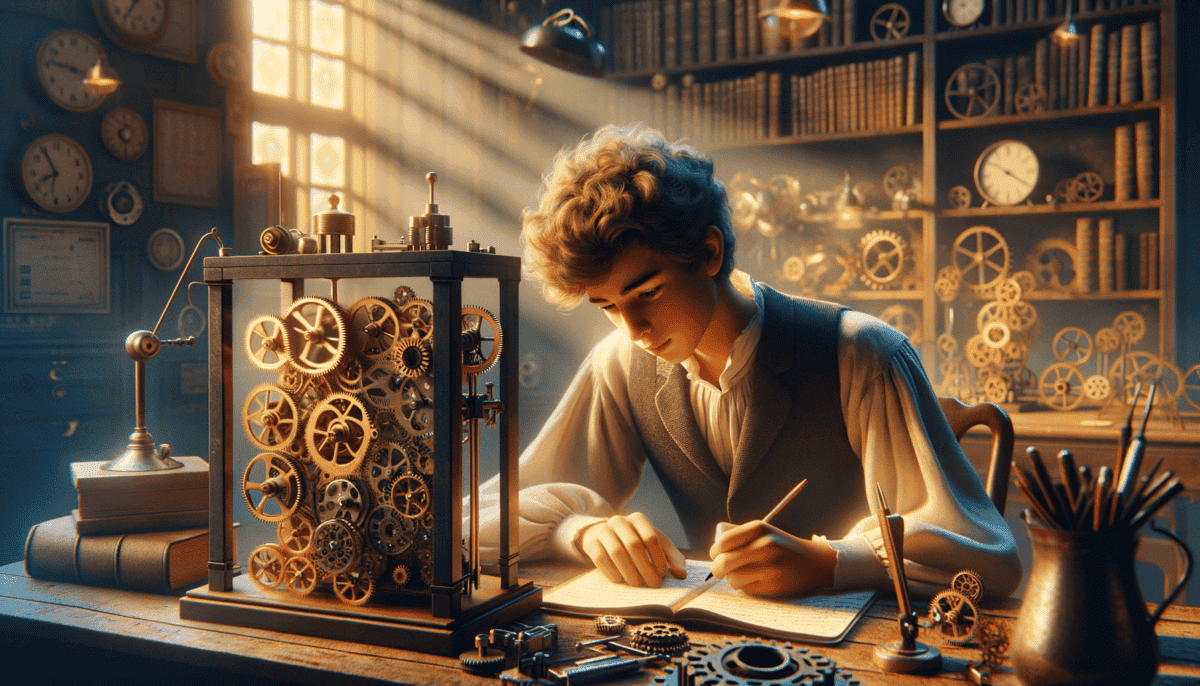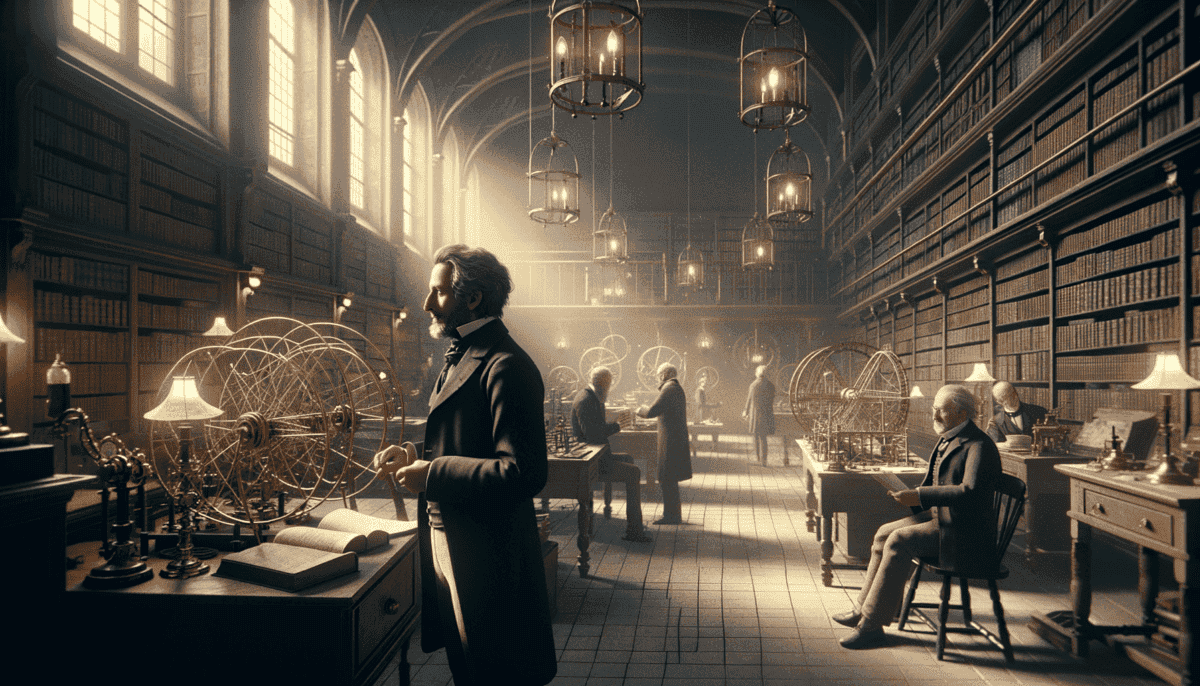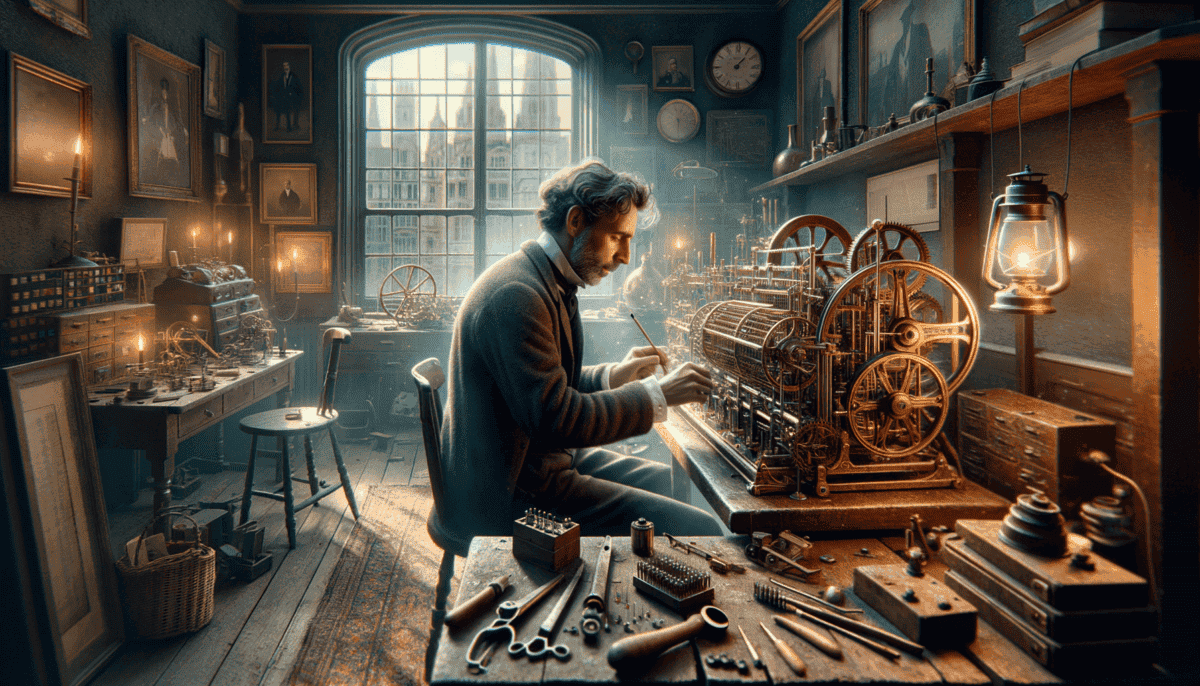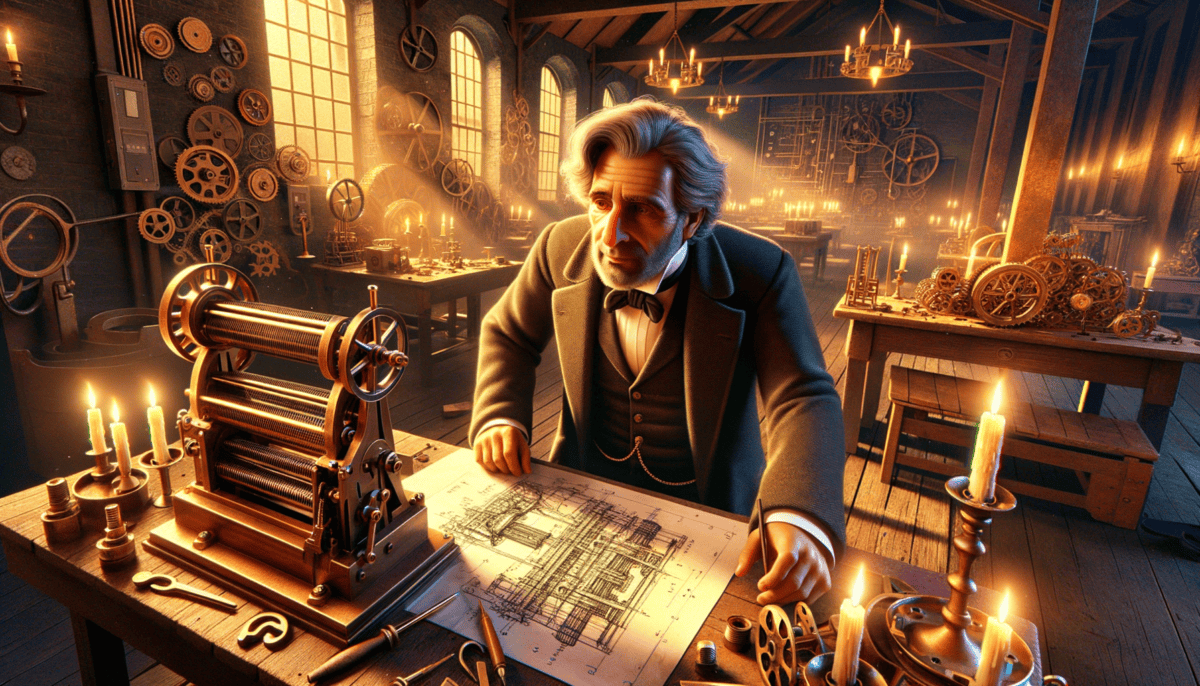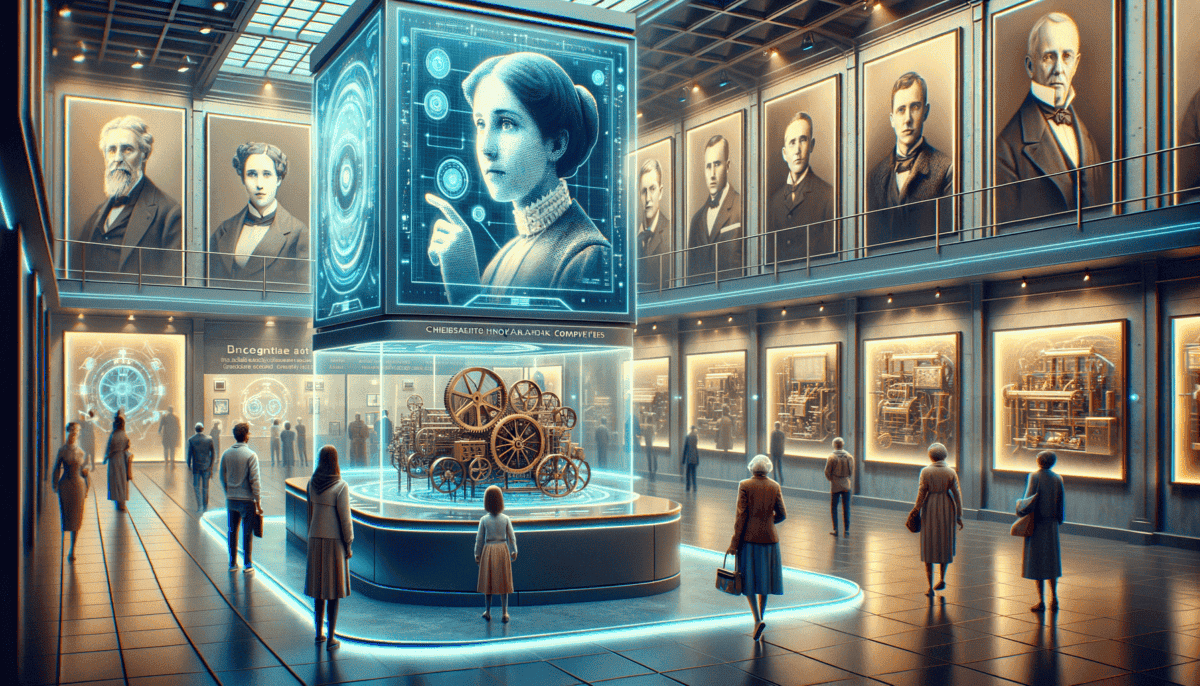A Curious Mind
Little Charles peered out his bedroom window, watching raindrops race down the glass. It was 1797 in London, and the eight-year-old boy was supposed to be sleeping. But his mind buzzed with questions, just like it did every night.
“One day, I’ll make a machine that can count all these raindrops,” he whispered to himself, his eyes sparkling with wonder.
Young Charles Babbage loved to ask “How?” and “Why?” about everything he saw!
Charles wasn’t like other kids. While they played with toy soldiers, he took apart his toys to see how they worked. His parents often found him surrounded by pieces of clockwork and gears.
“Charles,” his mother would say, shaking her head with a smile, “what are you up to now?”
“I’m learning, Mama!” he’d reply, his hands covered in oil from old clock parts.
At his school in Devon, Charles was different too. While other students struggled with numbers, he zoomed through math problems like they were simple games. His teachers were amazed!
“I’ve never seen a student solve problems so quickly,” his math teacher told the class one day. Charles just smiled and asked for harder problems to solve.
But it wasn’t all easy. Some kids made fun of him for being “too smart.” One day, after being teased during lunch, Charles ran to his favorite spot under a big oak tree.
“Why can’t they understand?” he wondered. “Numbers are like friends to me. They tell such interesting stories!”
The Special Book
One rainy afternoon, Charles found an old book in his father’s library. It was full of drawings of machines. His eyes grew wide as he turned each page.
“Papa!” he called out excitedly. “Could we build something like this?”
His father looked at the book and smiled. “Maybe someday, Charles. First, you need to learn more about mathematics.”
From that day on, young Charles spent every spare moment studying numbers and machines. He would sit for hours making drawings of weird and wonderful inventions in his notebook.
• A box that could solve math problems
• A machine that could remember numbers
• A device that could think like a person
At night, before bed, Charles would write in his diary about his big dreams. “One day,” he wrote, “I will build a machine that can think. It will help people solve big problems and make fewer mistakes.”
His mother would often find him asleep at his desk, surrounded by papers covered in numbers and drawings. She’d gently wake him and guide him to bed.
“Sweet dreams, my little inventor,” she’d whisper, knowing in her heart that her son was special.
As Charles grew, so did his ideas. Everyone could see that this wasn’t just a phase – this curious little boy was going to change the world. He just didn’t know it yet.
The Cambridge Years
The morning sun sparkled through Trinity College’s grand windows. Charles Babbage, now a young man of 19, could hardly believe he was finally at Cambridge University. His heart raced with excitement.
“Welcome to Trinity College,” announced Professor Peacock, his new mathematics teacher. “This is where great minds come to grow.”
At Cambridge, Charles found other students who loved numbers as much as he did!
On his first day, Charles met John Herschel, who would become his best friend. They both shared a deep love for mathematics.
“Look at this problem,” John said, showing Charles a complex equation. “I’ve been stuck on it for hours!”
Charles’s eyes lit up. Together, they worked until they solved it. It was the start of a wonderful friendship.
The Analytical Society
Charles wasn’t happy with how math was taught at Cambridge. He thought there were better ways to learn.
“Why do we keep using old ways to solve problems?” Charles asked during a meeting. “We need new ideas!”
His friends nodded in agreement. They began writing new math books and sharing better ways to solve problems.
The First Big Idea
One night, while working on a tough math problem, Charles had a special thought. He was tired of making mistakes when doing long calculations.
“What if,” he wondered out loud, “I could build a machine that never makes mistakes with numbers?”
He grabbed his notebook and started drawing. His hands moved quickly as he sketched his ideas.
• A machine with many gears
• Special wheels that could count
• Parts that could remember numbers
“This is brilliant!” John exclaimed when Charles showed him the drawings. “But can you really build it?”
Charles smiled. “I don’t know yet, but I’m going to try!”
Growing Success
Charles worked hard at Cambridge. His teachers were amazed by his clever ideas. He wrote special papers about mathematics that made other scientists take notice.
“You have a remarkable mind,” Professor Peacock told him one day. “Keep thinking differently.”
Charles spent his free time in the university’s workshop, learning about gears and machines. He would often skip meals, too excited about his work to eat.
“Someday,” he told John, “these machines will help everyone, not just mathematicians.”
A New Purpose
As his time at Cambridge came to an end, Charles knew what he wanted to do with his life. He would build machines that could think with numbers.
“The world needs this,” he said to his professors. “And I’m going to make it happen.”
His years at Cambridge had changed him. He wasn’t just a dreamy boy anymore – he was becoming a true inventor. And his biggest ideas were still to come. ⭐
The Birth of the Difference Engine
Charles sat at his desk, surrounded by piles of papers covered in drawings. His hand moved quickly across a fresh sheet as he sketched his newest idea.
“This is it!” he exclaimed, holding up his drawing. “A machine that can solve math problems all by itself!”
The Difference Engine would be as big as a room and have thousands of parts working together!
A Big Dream Takes Shape
Charles showed his plans to important people in London. They were amazed by his idea.
“Mr. Babbage,” said Sir Humphry Davy, a famous scientist, “your machine could change everything!”
Charles hired the best toolmakers in London. They started making tiny metal parts for his machine.
“Each piece must be perfect,” Charles told them. “Even one small mistake could ruin everything.”
Building the Dream
Making the Difference Engine was harder than anyone thought. Every gear had to be cut just right.
“Why won’t it work?” Charles would ask late at night, looking at broken parts. But he never gave up.
• The tools weren’t good enough
• Parts kept breaking
• It cost too much money
• Some people didn’t believe it would work
Charles spent hours watching the workers make parts. He wanted everything to be perfect.
“Look!” he said one day, showing off a working piece. “It can add numbers all by itself!”
Not Everyone Understands
Some people laughed at Charles’s big machine.
“Why do we need a machine to do math?” they asked. “We can use our brains!”
But Charles knew better. He had seen too many mistakes in math books.
“My machine will never make a mistake,” he would say. “It will always get the right answer.”
Small Victories
After years of work, Charles had a small part of his machine working. It could solve simple math problems!
“It’s beautiful,” said Ada Lovelace, a young woman who understood Charles’s dream. “Like a mathematical poem in metal.”
People came from far away to see the machine work. They watched in wonder as it clicked and whirred, solving problems on its own. ⚙️
Looking Forward
Even though building the Difference Engine was hard, Charles kept thinking bigger.
“This is just the start,” he told Ada. “I have ideas for an even better machine!”
His mind was already racing with new plans. The Difference Engine was just the first step in his amazing journey. ✨
Each night, as he looked at his drawings and parts, Charles dreamed of a future where machines could think. He didn’t know it then, but he was building the path to the computers we use today.
A Meeting of Brilliant Minds
One sunny morning in London, Charles heard a knock at his door. A young woman in a fancy dress stood there, her eyes bright with excitement.
“Mr. Babbage,” she said with a smile, “I’m Ada Lovelace. I’ve read all about your amazing machine!”
The Start of Something Special
Charles and Ada sat in his study, surrounded by drawings and gears. She understood his ideas better than anyone else had.
“Your machine isn’t just for numbers,” Ada said. “It could work with any kind of symbols!”
Charles’s eyes lit up. Finally, someone who saw what he saw!
Two Minds Working Together
Ada visited Charles’s workshop often. They would talk for hours about new ideas.
“Look at this,” Charles would say, showing her his latest drawings.
Ada would study them carefully, then add her own clever ideas. She wrote many notes about how the machine could work.
Teaching and Learning
Charles taught Ada about his machines. Ada taught Charles new ways to think about them.
“The machine could make music!” Ada suggested one day.
“It could draw pictures too,” Charles added, getting excited.
Together, they dreamed up ways the machine could do more than just math.
Writing History
Ada worked hard to explain Charles’s ideas to others. She wrote long papers about the machine.
“People need to understand how important this is,” she said, writing late into the night. ✍️
• How the machine worked
• What it could do
• Why it was important
• How to give it instructions
Beyond Numbers
Ada saw something nobody else did. She knew the machine could be more than a calculator.
“Your machine could work with words and pictures,” she told Charles. “It could make art!”
Charles was amazed by her ideas. Together, they were thinking about things that wouldn’t be possible for another hundred years!
Friends and Partners
Charles and Ada became great friends. They shared their biggest dreams with each other.
“We’re building the future,” Ada would say.
“Yes,” Charles would answer, “and nobody else knows it yet!”
They worked together for many years, pushing each other to think bigger and dream more. Their friendship changed the world, even though they didn’t know it at the time.
Every day, Ada would arrive with new ideas, and Charles would share his latest plans. Together, they were laying the groundwork for something that would change everything – the modern computer.
Dreams and Struggles
Charles Babbage sat at his desk, looking at his plans for a new machine. This one would be even better than his first!
A Bigger Dream
“I’ll call it the Analytical Engine,” Charles said to himself, drawing new designs. This machine would be amazing – like a giant metal brain!
But building it wasn’t easy. Charles needed lots of money and special parts that were hard to make.
Hard Times
Charles walked to the government office, holding his plans. “Please,” he said, “I need more help to build my machine.”
The man behind the desk shook his head. “We already gave you money for the first machine. This one seems too complicated.”
“Nobody understands,” Charles wrote in his diary that night. “This machine could change everything!”
Never Giving Up
Even when things got hard, Charles kept working. He used his own money to buy parts. He stayed up late drawing new plans.
“Maybe it’s too big,” people told him.
“Maybe it won’t work,” others said.
But Charles wouldn’t listen. He knew his idea was good, even if nobody else did.
• Memory to store numbers
• A processor to do math
• A way to input instructions
• A printer for answers
Working Alone
Ada was sick and couldn’t visit as much. Charles missed talking to her about his ideas.
He worked in his workshop, surrounded by gears and metal parts. Sometimes he would talk to himself, explaining how everything would work.
“First, the numbers go here,” he would say, pointing to his drawings. “Then the machine thinks about them here…”
Keep Dreaming Big
Even when he was tired, Charles didn’t stop dreaming. He knew his machine was important.
“One day,” he told his visitors, “machines like this will help people do amazing things!”
Looking Forward
Charles kept working on his plans, making them better and better.
“The world isn’t ready yet,” he wrote in his notebook. “But someday, it will be.”
He didn’t know it then, but he was right. His big dreams would help people build real computers many years later.
Every night, before he went to bed, Charles would look at his drawings one more time. He smiled, knowing that even if people didn’t understand now, his ideas were good. He was building the future, one gear at a time. ⚙️
A Legacy That Changed the World
Many years after Charles Babbage lived, people finally understood how amazing his ideas were.
The Future Arrives
“Look at these old drawings,” a scientist said in 1940, holding up Charles’s plans. “This man knew about computers before they existed!”
The scientist was right. The first real computers were a lot like what Charles had dreamed about. They had memory and could do math, just like his Analytical Engine.
A Dream Comes True
Today, we have computers everywhere:
• In our homes
• At schools
• In phones
• Even in toys!
Charles would be so happy to see this! His dream of machines helping people came true.
“Every time you play on a computer or tablet, you’re using ideas that Charles Babbage thought of first!” – Modern Computer Scientist
Remembering a Hero
People now call Charles “The Father of Computing.” They put his picture in museums and tell his story in books.
Ada Lovelace is remembered too! She’s called “The First Computer Programmer” because she wrote instructions for Charles’s machine.
✨ Never give up on your dreams
✨ Keep trying even when things are hard
✨ Sometimes big ideas take time to come true
The Story Lives On
“What would Charles think of our computers today?” a young student asked their teacher.
“I think he would smile,” the teacher said. “He knew computers would change the world.”
Looking to Tomorrow
Every time someone invents something new for computers, they’re building on Charles’s ideas. His dream keeps growing bigger!
Maybe you’ll have an amazing idea someday too. Just remember Charles Babbage, who dreamed of computers when most people couldn’t imagine such things.
The best part? The story of computers isn’t over. New ideas come every day, making Charles’s dream even bigger and better. And it all started with one man who dared to think differently.

